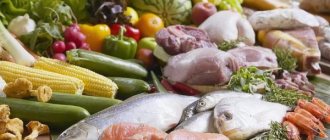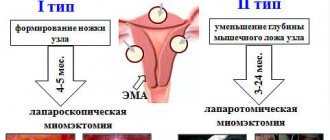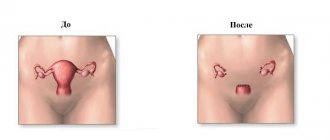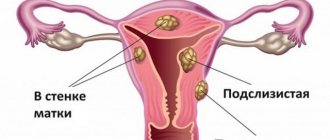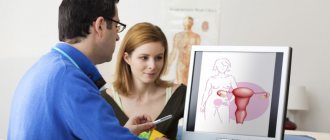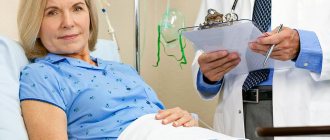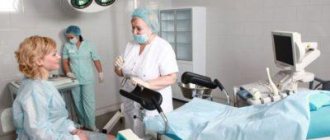Nutrition after removal of the uterus and ovaries plays an important role in the rehabilitation period. After surgery, the woman is prescribed a special diet, which she must adhere to for a certain time.
Removal of the uterus (hysterectomy) and ovaries is a last resort in the treatment of gynecological diseases. It is used mainly in the presence of malignant tumors, at risk of degeneration of cysts, benign tumors, as well as for injuries resulting in extensive uterine bleeding. Can be performed at any age if indicated. Modern technologies determine the successful outcome of such an operation. But a woman should subsequently pay great attention to restorative procedures.
Nutrition after hysterectomy, what can you eat?
The operation to remove the uterus is considered one of the most difficult.
But very often such surgical intervention saves the patient’s life, so it is necessary. In the postoperative period, it is very important to provide proper care and select effective methods of treatment and recovery. But it is equally important to take care of proper nutrition, which will help replenish the deficiency of nutrients after surgery and restore strength.
In this article we will talk about what nutrition should be like after removal of the uterus, what you can eat in the early and late postoperative period, and what your diet should be like so that the body quickly recovers after surgery.
What diseases can cause removal of the uterus
For normal functioning of the uterus, a woman must have hormonal balance. After the removal of an organ, a woman’s metabolic processes in the body are disrupted, and the main thing during this period is to normalize them, restore hormonal levels and increase the ability to recover so that the sutures heal as quickly as possible.
There are many reasons why a woman may have an organ removed:
- oncology;
- myoma;
- endometriosis;
- pelvic inflammatory diseases.
In any of these cases, diet becomes a “lifeline” for quick and high-quality restoration of the female body. Serious interference with the reproductive system has a negative impact on physical and emotional health. Therefore, a woman needs to survive this condition more gently, replenishing her diet with the necessary elements to improve her overall health.
Hysterectomy: nutrition after surgery
In the early postoperative period, the patient needs to avoid dehydration, so drinking regimen is very important. You need to drink at least 1.5 liters of clean water. As for food, it is necessary to follow the principle of gradually expanding the diet, first introducing liquid and semi-liquid dishes into the menu, then moving on to more solid foods.
In the early postoperative period, food after removal of the uterus should be unsalted (to eliminate fluid retention and the appearance of edema), low-fat and non-spicy, but at the same time the body should receive a sufficient amount of vitamins and microelements.
Meals should be fractional, you need to take food up to 6-7 times a day in small portions. Nutrition after hysterectomy should be aimed at restoring intestinal function.
Since after surgery on the pelvic organs there is a risk of postoperative sutures diverging, you should not eat foods that can lead to constipation and flatulence (white bread, pastries, chocolate, strong tea, coffee).
The calorie content of food is increased gradually so that the gastrointestinal tract has time to adapt after surgery and begin to function normally. Nutrition after removal of the uterus should include crumbly cereals, fresh vegetables and fruits, vegetable oils, lean meat, and dairy products.
After surgery to remove the uterus, the patient often experiences a decrease in hemoglobin. Eating dried apricots, pomegranate juice, buckwheat, and lean meat (veal) will help avoid anemia.
Dietary recommendations after hysterectomy should be followed for 2-4 months, after which you can switch to a normal diet.
Nutrition for uterine cancer
Nutrition for uterine cancer
Many books have been written about the benefits of a healthy and proper diet, however, few people know that a properly composed diet of healthy foods is one of the main components in the treatment of cancer. A strictly balanced diet for uterine cancer can increase the effectiveness of treatment, and in some cases even slow down the development of the pathological process.
Experts in the field of medicine have proven that the factors that provoke the development of uterine cancer include poor nutrition, namely the consumption of harmful foods that provoke metabolic disorders in the body. Therefore, proper nutrition, that is, a properly formulated diet, is of great importance for women with uterine cancer.
Features of proper nutrition for uterine cancer
The diet of patients with uterine cancer involves the consumption of a number of natural products that have properties to slow down or prevent the development of cancer cells. A properly designed daily diet should be aimed at solving several problems, namely:
- contain components that reduce the development of tumor cells;
- improve the condition of the body, increase its energy;
- increase the body's protective properties;
- improve the functioning of the immune system.
This is possible only with a complete rejection of semi-finished products, fast foods, products containing preservatives or other artificial additives. Thus, nutrition for malignant lesions of the uterus should be based on eating food of plant origin, since it has a positive effect on the functioning of organs and systems, and also improves overall well-being and improves mood.
Avoiding fast food
Cancer cells, when multiplying, absorb large amounts of energy, weakening the body.
The diet for oncology should be designed in such a way as to replenish the affected body with vitamins every day and preserve the energy received as much as possible.
Increasing energy balance helps improve the functioning of the immune system, which allows the body to independently fight the development of cancer.
At later stages of development of the pathology, rapid loss of body weight occurs, and exhaustion of the body occurs. This fact should also be taken into account when drawing up a nutrition plan. Dishes eaten must retain a maximum of nutrients necessary for the functioning of the sick organism.
Diet for uterine cancer
To create the right diet for uterine cancer, you should use products that have anti-cancer properties. It is very important to find the right combination of them, as this will help increase the effectiveness of the diet. These properties have:
- broccoli, cauliflower, white cabbage or Brussels sprouts;
- garlic, onion, asparagus;
- root vegetables - carrots, beets, potatoes;
- legumes – beans, peas, soybeans;
- whole grain or sprouted cereals;
- fresh vegetables and fruits;
- spicy greens.
To preserve biologically active components, products should be subjected to minimal heat treatment and steamed, and it is better to try to eat them raw.
In your daily diet, you should try to consume at least 3-4 servings of fresh vegetables and fruits (mostly brightly colored).
Traditional red meat should be replaced with fish rich in polyunsaturated acids or lean poultry.
Nutrition for cervical cancer
Nutrition for cervical cancer
The diet for cervical cancer, as for uterine cancer, has no fundamental differences.
It definitely involves the use of the above products, as well as the consumption of low-fat fermented milk products.
It is imperative to enrich your diet with dishes containing sprouted grains and whole grains. They are a source of valuable nutrients.
The special substance lycopene contained in tomatoes has protective properties. Its digestibility increases when consuming tomatoes with cold-pressed olive oil, which is recommended to be eaten daily. Olive oil has a complex composition that prevents the occurrence of metastases in the body.
An important component of nutrition for uterine cancer is soy and soy products. They are an essential source of protein, as well as special substances that slow down tumor development. Tofu and soy yoghurts are healthy products and perfectly neutralize toxic compounds.
A properly designed diet for cervical cancer is very important for the patient, since it consists only of healthy dishes, and involves the complete exclusion of harmful foods from the diet, which include:
- strong tea and alcoholic drinks;
- chocolate, cocoa, and their derivatives;
- confectionery;
- spicy and salty dishes;
- smoked meats and fatty foods;
- fast foods and semi-finished products;
- products containing artificial additives.
Nutrition for cancerous lesions of the uterus should be supplemented with infusions or decoctions of medicinal herbs, alcohol tinctures prepared at home. However, it should be remembered that only the attending physician should be involved in developing the correct diet.
Source: https://www.no-onco.ru/pitanie-pri-rake/pitanie-pri-onkologii-matki.html
Nutrition after hysterectomy in the early postoperative period
In the first days (1-3 days) after gynecological operations, doctors recommend following diet No. 1A or 1B.
The main products that can be consumed: pureed mucous soups (cereal, milk), liquid porridges with water or milk, soft-boiled eggs or steam omelet, milk (if there are no signs of flatulence), vegetable oil, fruit or berry jelly, juices, weak tea with milk, rosehip decoction.
On the second or third day after surgery, you can eat meat or fish dishes, pureed and steamed, and pureed steamed vegetables.
Limit salt and sugar; additionally, you need to take vitamin complexes. You need to eat every two to three hours, the food should be warm.
Sample daily menu
You need to start your day with breakfast. It is advisable to eat a dish high in fiber - cereals, for example, buckwheat. It should be boiled in water with the addition of butter. If desired, you can add low-fat milk.
After 2-3 hours there should be a second breakfast. You can eat an apple, low-fat cottage cheese or a handful of walnuts.
The postoperative diet must include the consumption of carbohydrates.
They must be absorbed by the body at lunchtime. The ideal option is a light vegetable soup or “third broth”. The last dish is prepared simply: after the water in which the chicken is cooked boils, it needs to be drained. The container with meat is refilled with water and placed on the fire. The manipulation must be repeated twice.
Nutrition after hysterectomy in the late postoperative period
On days 5-6 after surgery, you can move on to table No. 15. This is a complete diet with sufficient calories and the necessary set of nutrients and vitamins with the exception of fatty, spicy, indigestible foods.
It should be remembered that it is necessary to expand the diet gradually, monitoring the body’s reaction and your feelings. On average, to restore strength after surgery, you need a balanced diet with a calorie content of 2800-2900 kcal, while protein should be 90-95 grams, fat - 100-105 grams, carbohydrates - 400 grams.
The menu should include meat and fish dishes, seasonal vegetables and fruits, cereal dishes, dairy and fermented milk products. You should avoid products with artificial additives (dyes, flavors), refractory animal fats, hot seasonings and spices, and sweets in large quantities.
Do not forget about sufficient fluid intake: preference should be given to fruit juices, herbal decoctions, weak tea, and still mineral water.
Gradually expanding the diet, you can move on to a common table. In any case, surgery is an additional burden on the body, so do not forget about proper nutrition with a set of necessary nutrients.
There is a misconception that diet only helps with diseases of the gastrointestinal tract. In fact, strict restrictions and shifts in the balance of the diet in favor of a certain type of food are prescribed by doctors for many pathologies.
Many people who want to lose excess weight try to do it in the shortest possible time. Of course, you want to get your body in order in a few days, but this approach to solving the problem often leads to the opposite results - the lost kilograms are returned with a reserve.
Fully or partially limited products
Meals after hysterectomy should not contain:
- Semi-finished products, fast food, shelf-stable products and those with chemical additives, fatty red meat.
- Sausages, smoked meats, refractory, animal/cooking fats, margarine, mayonnaise, canned fish/meat.
- For the first time after surgery, it is worth limiting the consumption of legumes and vegetables that cause bloating: garlic, peas, lentils, beans, soybeans, onions, peppers, cabbage.
- The consumption of offal is limited to once every 2 weeks.
- It is not advisable to consume rich meat/fish broths, spicy and pickled vegetables.
- Carbonated drinks, strong tea, strong coffee, packaged juices.
- The consumption of confectionery products, sugar, products made from refined flour, whole milk, yeast, and baked goods is limited.
Table of prohibited products
| Proteins, g | Fats, g | Carbohydrates, g | Calories, kcal | |
Vegetables and greens | ||||
| canned vegetables | 1,5 | 0,2 | 5,5 | 30 |
| horseradish | 3,2 | 0,4 | 10,5 | 56 |
Mushrooms | ||||
| mushrooms | 3,5 | 2,0 | 2,5 | 30 |
Confectionery | ||||
| pastry cream | 0,2 | 26,0 | 16,5 | 300 |
| cake | 3,8 | 22,6 | 47,0 | 397 |
| shortbread dough | 6,5 | 21,6 | 49,9 | 403 |
Cakes | ||||
| cake | 4,4 | 23,4 | 45,2 | 407 |
Chocolate | ||||
| chocolate | 5,4 | 35,3 | 56,5 | 544 |
Raw materials and seasonings | ||||
| mustard | 5,7 | 6,4 | 22,0 | 162 |
| ketchup | 1,8 | 1,0 | 22,2 | 93 |
| mayonnaise | 2,4 | 67,0 | 3,9 | 627 |
Dairy | ||||
| cream 35% (fat) | 2,5 | 35,0 | 3,0 | 337 |
Meat products | ||||
| fatty pork | 11,4 | 49,3 | 0,0 | 489 |
| salo | 2,4 | 89,0 | 0,0 | 797 |
| bacon | 23,0 | 45,0 | 0,0 | 500 |
| raw smoked pork belly | 7,6 | 66,8 | — | 632 |
Sausages | ||||
| smoked sausage | 16,2 | 44,6 | 0,0 | 466 |
| dry-cured sausage | 24,1 | 38,3 | 1,0 | 455 |
| smoked sausage | 9,9 | 63,2 | 0,3 | 608 |
Bird | ||||
| fried chicken | 26,0 | 12,0 | 0,0 | 210 |
| smoked chicken | 27,5 | 8,2 | 0,0 | 184 |
| duck | 16,5 | 61,2 | 0,0 | 346 |
| smoked duck | 19,0 | 28,4 | 0,0 | 337 |
| goose | 16,1 | 33,3 | 0,0 | 364 |
Fish and seafood | ||||
| dried fish | 17,5 | 4,6 | 0,0 | 139 |
| smoked fish | 26,8 | 9,9 | 0,0 | 196 |
| canned fish | 17,5 | 2,0 | 0,0 | 88 |
Oils and fats | ||||
| creamy margarine | 0,5 | 82,0 | 0,0 | 745 |
| cooking fat | 0,0 | 99,7 | 0,0 | 897 |
| rendered pork fat | 0,0 | 99,6 | 0,0 | 896 |
Non-alcoholic drinks | ||||
| Pepsi | 0,0 | 0,0 | 8,7 | 38 |
| sprite | 0,1 | 0,0 | 7,0 | 29 |
| tonic | 0,0 | 0,0 | 8,3 | 34 |
| Fanta | 0,0 | 0,0 | 11,7 | 48 |
* data is per 100 g of product
What should be the diet after hysterectomy surgery?
The operation to remove the uterus is considered one of the most difficult in surgical practice. It often saves the lives of seriously ill patients. During the recovery period after surgery, it is important to give the body all the necessary substances for a speedy recovery and to avoid consuming substances that worsen health. In the article we will talk in detail about the diet after surgery to remove the uterus, what foods are allowed and prohibited to eat in the early and late postoperative period, so that the body recovers faster.
Why do you need a diet after hysterectomy?
Immediately after removal of the uterus, the female body loses one of the most necessary organs to ensure normal functioning, so the first days will be quite difficult. The more manipulations were performed during the operation, the more painful the woman will feel.
To facilitate the body’s task, the patient needs to create favorable conditions, namely not to burden the body with heavy food and a lot of movement. But today we will talk about diet, since it plays a key role.
Immediately after the operation, the most difficult days begin; they should be as gentle as possible for the body. Additionally, there should be a large amount of drinking water to speed up metabolic processes in the body, and it is also recommended to eat only unsalted food.
It is considered a mandatory procedure so that the body does not remain without the amount of water necessary for restoration during this period. A lack of fluid will slow down all processes, weaken the surgical intervention, and the woman will take longer to recover.
Reasons for having a hysterectomy
For women of childbearing age, radical hysterectomy is performed in exceptional cases, for example, with malignant processes in the ovaries. In other cases, they try to preserve the appendages. Indications for such an operation in postmenopausal women are much wider, because Removal of the uterus and ovaries has virtually no effect on further quality of life.
Indications for radical hysterectomy:
- Malignant tumors of the pelvic organs;
- Extensive uterine fibroids;
- Endometriosis (in cases where other therapy is powerless);
- Some types of cysts in postmenopausal women;
- Uterine prolapse;
- Other pathologies in the absence of a positive response to conservative treatment methods.
What diet rules should you follow?
Immediately after the operation, the woman is prescribed a diet. She undergoes a routine examination, where they find out about her well-being and examine the area with stitches. The doctor prescribes a diet, during the process the woman is observed by a doctor, and he accordingly adjusts the diet to the body’s reaction.
Recovery after surgery is divided into two types, but in any case it will take a long time. Because of this, the stages are divided into:
- early – this is the first week after surgery, which is considered the most difficult;
- late – the second and subsequent weeks until complete recovery, at which time the woman feels much better.
The diet should be like increasing the body's resistance in order to recover faster. It is important at this time to consume as much protein food and vitamin complexes as possible in order to normalize the functioning of the intestines and eliminate constipation and flatulence.
Diet rules at the initial stage
In the first days and week, it is important to ensure rapid healing of the sutures, so it is highly recommended not to push. After this, the intestines should take an active part in the work; for this, the woman will need to include in her diet:
- a little low-fat kefir;
- water.
Kefir is drunk several times a day in small portions. Water is consumed during breaks, also in small portions to speed up metabolism. Doctors recommend drinking as much water as possible throughout the recovery period to make it easier to cope with new stress.
In the following days, you can switch to soups and broths. On the third day, you can add a little steamed meat to your diet. All dishes are served in small portions and always warm.
Additionally, in the morning you can eat porridge with water or milk with the lowest fat percentage, unless your doctor prescribes a special menu. You can drink compotes, eat omelettes, teas, fish and steamed meat. At the same time, drink at least two liters of water per day.
Late stage
In subsequent weeks, at a later stage, the energy value of food per day can be no more than 2900 kcal. That is, a person should eat 800 g of food per day. It is mandatory to contain 600 g of carbohydrates, 100 g of fat and 90 g of protein food.
The menu is compiled based on the individual characteristics of the patient’s body. But the same course for everyone is to eat many times and in small portions so as not to burden the body.
To avoid anemia, you should include pomegranate juice, walnuts and buckwheat in your diet. Additionally, doctors prescribe vitamin courses for faster stomach recovery.
Reviews and results
There is no specially designed diet for cancer. In general, food does not have significant restrictions and corresponds to a healthy diet. In each specific case, taking into account the patient’s conditions, adjustments are made. A properly organized healthy diet can speed up rehabilitation after chemotherapy and radiation therapy and normalize the condition.
- “...I had surgery, plus chemotherapy and radiation. It was difficult to bear everything. The prognosis was not encouraging, but you have to get through it! I followed the diet strictly, began to eat more vegetables, cereals, vegetable oils and fish. There were no problems with the intestines, I didn’t feel weak or bloated, and this allowed me to eat a lot of seasonal vegetables. I eat chicken twice a week. I tolerate all products well. I see a doctor every six months and have been leading the life of a healthy person for three years now”;
- “... They removed the uterus and ovaries, underwent chemotherapy, but did not undergo radiation. However, the recovery was long. As a result of treatment, I lost a lot of weight and became weak - there was vomiting, nausea, and then there was no appetite for a long time. The doctor recommended a nutritious diet, which I could only do between chemotherapy courses. Only after 2 months did I manage to regulate my diet - I began to enjoy eating fish, stewed vegetables, honey, nuts, yogurt (I made it myself) and porridge”;
- “... Three years have passed since the removal of the uterus. The first two months were difficult: poor appetite, weakness, periodic nausea. I lost 6 kg. At first I strictly followed a diet, mainly rice, buckwheat, fish, cottage cheese, kefir, white chicken meat, omelettes, vegetables, fruits, honey and nuts. I drink a lot of water. After a year, I occasionally began to allow myself cakes and cakes, but otherwise my diet is correct. The weight has been restored, my hair has grown, I feel normal.”
What is strictly forbidden to eat
The list of prohibited products is quite lengthy. It includes all food products that can additionally burden the body, because the main forces should go into speedy healing of the sutures.
Rolls, bread, pies and any other baked goods
Milk, kefir, cheese, yogurt. You can’t even eat completely low-fat foods.
Tomatoes, cucumbers, zucchini, onions, dill, radishes, potatoes, corn, garlic, cabbage, lettuce, eggplant, basil, peas, asparagus, etc.
Mayonnaise, tartar, remoulade, meuniere, salsa, pesto, bolognese, satsebeli, tkemali, horseradish, chili, adjika, tabasco, barbecue, chocolate, fruit, vanilla, caramel, ketchup, soy, guacamole, bechamel, thousand islands, etc. .
Juices, cola, cocoa, coffee, alcohol and any other carbonated drinks
Sugar, honey, cream, meringue, jam, jam, marmalade, jelly, marshmallows, sweets, toffee, caramel, lollipops, that is, any products with a large or minor addition of sugar
Frozen cutlets, dumplings, semi-finished fish products, etc.
Additionally, the use of all types of seasonings that can cause stomach irritation is prohibited. Do not fry or eat smoked foods. Anything that must be heat treated can only be boiled or cooked in a steam bath. It is possible to bake or stew with a minimum amount of oil, or best without it at all.
What can you eat after surgery?
It is important to know that:
- In the first hours after surgery, you can drink only a small amount of water without gases.
- After a while, you can start eating low-fat broths and kefir, also in small portions.
- Products should be natural and nutrient-dense.
- You should avoid foods that can cause constipation or flatulence (the list of products in this case is entirely individual).
What can you eat
Porridges that are prepared on the basis of semolina, oatmeal, rice or pearl barley
Carrots, potatoes, turnips, pumpkin. Be sure to grind all ingredients into porridge or grind in a blender. Additionally, you can add cream, a small piece of butter or 1 beaten egg
Animals and fish. In the first days they are served in ground form. Be sure to remove the skin and veins.
Only products with the lowest fat content may be present
Eggs can only be eaten as an omelet.
Only those that are used by athletes during cutting. For example, apples, avocados, raspberries. No milkshakes or compotes to avoid bloating
Rose hip decoction, weak tea, water. They can't be sweetened
Olive, butter, sunflower
Strict adherence to the diet will help a woman survive a rather difficult period for the body.
Nutritional considerations before surgery
Preparing for a hysterectomy for uterine cancer requires adherence to a diet. The day before surgery, the patient is recommended to:
- exclude indigestible foods that irritate the intestinal mucosa;
- Avoid foods that cause increased gas formation (beans, peas, beans, cabbage).
Food should be easily digestible and contain vitamins. Before surgery, it is recommended to eat vegetables, fruits, and a small portion of cereal porridge. Exclude fermented milk and dairy products.
Menu for the week
They are on a diet after surgery for about 3 months, so we have compiled a food menu for the week. All components can be swapped from week to week:
- Breakfast: rice porridge with water
- Second breakfast: kefir
- Lunch: vegetable soup, kefir
- Afternoon snack: fruit
- Dinner: buckwheat porridge
- Breakfast: semolina porridge on water
- Second breakfast: jelly with a slice of bread
- Lunch: steamed meat or fish, kefir
- Afternoon snack: fruit
- Dinner: vegetables with fish
- Breakfast: pearl barley porridge on water
- Second breakfast: kefir with dried fruits
- Lunch: stewed or fresh vegetables, jelly
- Afternoon snack: yogurt
- Dinner: vegetables with meat
- Breakfast: oatmeal with water
- Second breakfast: jelly
- Lunch: steamed poultry or fish with vegetables, tea
- Afternoon snack: any fruit
- Dinner: buckwheat porridge
- Breakfast: semolina porridge on water
- Second breakfast: weak tea
- Lunch: steamed or stewed vegetables, jelly
- Afternoon snack: yogurt
- Dinner: vegetables with meat
- Breakfast: oatmeal with water
- Second breakfast: rosehip decoction
- Lunch: vegetable soup, tea
- Afternoon snack: jelly
- Dinner: buckwheat porridge
- Breakfast: pearl barley porridge on water
- Second breakfast: low-fat kefir
- Lunch: fish with vegetables, kefir
- Afternoon snack: kefir
- Dinner: buckwheat porridge
If you plan your menu correctly, your diet can be more varied.
Menu (Power Mode)
The diet can be varied by including different vegetables, cereals and fish dishes. For breakfast, it is better to eat porridge, with the addition of milk if desired. Add different seeds, raisins, prunes, dried apricots, nuts or honey to them as often as possible.
For second breakfast - cottage cheese with fresh fruits or dried fruits. All kinds of cereal or vegetable soups can be prepared for lunch, supplementing it with salads of fresh vegetables, boiled chicken, turkey or fish, and seaweed. Fish and fish dishes are easier to digest and can be included in your diet every day.
Vegetable oils and butter should be used in ready-made dishes without subjecting them to heat treatment. Try to alternate vegetable oils in your diet to get omega-3 , omega-6 and omega 9 PUFAs. Eating various nuts, dried fruits and seeds can completely replace chocolate, sweets and confectionery.
Constipation or bloating
When operating on the pelvic organs, there is a high risk of subsequent constipation, bloating, etc. They can cause the sutures that have not yet healed to separate. Therefore, you should exclude from your diet foods that can cause such problems.
If you do experience constipation, then to eliminate it you need to take mild herbal preparations and balance your diet. Fermented milk products help well with problems with the gastrointestinal tract; their amount in the diet should be increased.
What is the opinion of women regarding this issue?
Unfortunately, a large number of women suffer from problems with the genitourinary system every year. It is very lucky if the disease is detected in a timely manner and treated in the early stages. But the reality is that the only way to get rid of the problem is partial or complete removal of the corresponding organ.
Most women who have undergone this procedure and who have taken advantage of the dietary recommendations say that this contributed to a faster recovery because it is through a properly balanced diet that a person receives most of the necessary substances for normal functioning.
Plus, deliciously prepared food creates a good mood, which also affects recovery. All details and suitable products for each woman are selected by a specialist who constantly monitors the patient’s health status, and therefore will help to respond correctly to side effects not only by changing the diet, but also by mild medications.
Women note that after such a diet they did not stop and introduced it into their diet on an ongoing basis. Because it was because of proper nutrition that the body felt much better and coped with stress faster. The diet was able to solve most of the previously existing problems. Plus, the removed part no longer hurt and allowed me to live a normal life.
Experts recommend that all women undergo an examination by a gynecologist at least once every six months in order to avoid health problems or similar situations where it would be necessary to remove the organ. It is constant attention and careful attitude towards the body that will help maintain health for many years to lead a full life.
Noticed a mistake? Select it and press Ctrl+Enter to let us know.
Advantages and disadvantages
| pros | Minuses |
|
|
General rules
The number of women suffering from genital cancer is growing every year. The most common location of neoplasms is the body of the uterus. More than 75% of patients with cancer of this location are pre- and postmenopausal women. At risk are younger patients with precancerous endometrial diseases (adenomatous polyps, atypical endometrial hyperplasia ).
If uterine cancer is detected at stages I and II, this allows for effective treatment. The standard method of treatment is surgical and in 90% of cases extirpation of the uterus and appendages is performed. For widespread tumors, removal of the iliac lymph nodes and radiation therapy .
Cervical cancer is the second most common , and it is important that there is a tendency towards an increase in patients at a young age. The management tactics for these patients are determined by the prevalence of the process. Currently, up to 40% of patients consult a doctor with widespread stage III–IV.
Surgical treatment is recommended in the initial stages and the scope of intervention varies from high cervical amputation and hysterectomy with appendages to extended hysterectomy with appendages. In this case, the quality of the operation becomes of fundamental importance. This refers to the removal of lymph nodes, which improves results in stages III-IV of the disease and unfavorable histological nature of the formation.
The surgical stage is performed using traditional abdominal and laparoscopic access. Laparoscopy is a low-traumatic operation that can be used to perform supravaginal amputation of the uterus and hysterectomy. More often it is used in general gynecology for benign formations: removal of ovarian cysts , leiomyoma , resection of ovaries for polycystic disease , as well as for eliminating external adhesions of the fallopian tubes. After laparoscopy, the fallopian tubes become patent, and pregnancy occurs in 60% of cases.
Recently, the accumulated experience of laparoscopy has made it possible to go beyond benign pathologies and perform operations in gynecological oncology. Long-term observations of the effectiveness of treatment and five-year survival of patients showed that there is no difference between the laparoscopic approach and the traditional one. Undoubtedly, surgery in gynecological oncology is an order of magnitude more complex than general gynecology.
Before laparoscopy, the woman is thoroughly examined, all possible complications of the operation are weighed, taking into account the removal of regional lymph nodes. For several days before the operation, a woman should not eat foods that cause bloating (honey, jam, legumes, cabbage, prunes), stop eating 8 hours before the operation and cleanse the intestines with a cleansing enema. The advantages of this type of intervention are low-traumatic and rapid recovery of the patient.
The treatment regimen for malignant tumors after surgery includes radiation and chemotherapy . As a rule, several drugs are combined, and this inevitably causes nausea, vomiting, and weakened immunity . If chemotherapy is not effective, a course of radiation treatment is carried out (intracavitary gamma therapy and remote therapy).
Practice shows that tumors of the same size, morphological type and location do not respond equally to radiation therapy, which is manifested by their regression to varying degrees. It depends on individual radiosensitivity. This difficult procedure is accompanied by digestive disorders, weight loss, anemia , leukopenia and general weakness. In addition, antitumor treatment leads to disruption of nutrient absorption. Of course, in such a patient’s condition, nutrition is of great importance.
Nutrition during radiation therapy of the uterus has some peculiarities. The fact is that after radiation therapy there are negative reactions. Early complications include nausea, vomiting, changes in taste, diarrhea , and aversion to food. Late - the appearance of intestinal strictures and the development of malabsorption syndrome .
Local complications of cervical radiation therapy include dryness and atrophy of the vaginal mucosa. To eliminate these phenomena, patients are prescribed Trioginal , which contains a lyophilized culture of lactobacilli , estriol and progesterone . They normalize vaginal microbiocenosis , restore the epithelium and improve blood supply.
All these phenomena can be corrected to some extent by nutrition. It is important that dietary therapy begins a week before the start of radiation therapy. The energy value of nutrition should replenish the plastic/energy needs of the body, while reducing intoxication of the body, increasing immunity and nonspecific factors of antitumor protection. When preparing a diet, you need to take into account the patient’s preferences as much as possible and prepare your favorite dishes.
During radiation therapy after removal of the uterus, it is necessary to ensure:
- Eat frequent and small meals, time snacks to coincide with the appearance of appetite.
- Diversify your diet by including freshly prepared juices, fresh vegetables and fruits. Orange-red-yellow vegetables and fruits increase the body's antitumor resistance: apricots, lemons, peaches, grapefruits, carrots, pumpkin, plums, tangerines, apples, tomatoes, beets, as well as broccoli, cauliflower and kohlrabi. It is advisable to include seaweed (kelp, kombu, spirulina), leafy greens, sprouted cereal grains, seeds, nuts, and bee products into the diet.
- To relieve nausea, eat sour and salty foods (lemons, cranberries, pickles).
- For nausea and vomiting, avoid foods that have a smell, excessively fatty foods and whole milk. These products are included after the nausea disappears.
- When anemia develops, the diet is enriched with foods containing iron: pistachios, lentils, liver, spinach, pomegranate juice. Also necessary for the restoration of hemoglobin are vitamin C , B12 and folic acid . Products containing them include: rose hips, sweet peppers, sea buckthorn, black currants, parsley, green salad, beets, peas, beans, spinach, pumpkin, cucumbers, green tops of vegetables, raspberries, carrots, bananas, melon, oranges, apricots, almonds, peanuts, walnuts, hazelnuts.
- of leukocytes decreases , red fish, fish caviar, carrot, apple, beet juice, barley decoction, oat decoction, ground buckwheat, doused with kefir overnight, red fruits, nuts, and seafood are recommended.
- Introduce high-energy products that provide energy needs in a small amount: red fish, cream, butter, sturgeon caviar, chocolate, sour cream, honey, nuts, porridge with vegetable oils, fish oil.
- To stimulate appetite, you can add spices and herbs to dishes (anise, cumin, rosemary, cloves, mint, marjoram, basil, turmeric, thyme, cinnamon). The diet should be as varied as possible due to decreased appetite and changes in the patient’s sense of taste.
- Free fluid intake is 1.5 l/day. It is recommended to take fermented milk drinks, table water, vegetable and fruit juices, and herbal tea.
- In your diet, you need to reduce the content of red meat, increasing the consumption of poultry, fish, eggs and dairy products. Preference is given to “live” homemade fermented milk products. They contribute to the normalization of microflora, which is the main anti-carcinogenic agent.
- Sparing the gastrointestinal mucosa by steaming or boiling food.
Need for diet
You can remove the uterus and ovaries using 2 methods: laparoscopic and hysterectomy (abdominal). Regardless of the strategy chosen by the surgeon, the patient undergoing such an operation must limit her diet.
The diet after removal of the uterus and ovaries is followed for the following reasons:
- On the first postoperative day, the patient is injected with antibiotics and painkillers. This therapy provokes a change in hormonal levels in the body. Because of this, girls often gain weight. To prevent this, the diet will have to be adjusted;
- During the removal of the appendages and uterus, the gastrointestinal tract may be affected, which will lead to its dysfunction. A well-planned diet will help improve the functioning of the stomach and intestines;
- A patient whose reproductive organs have been removed due to the development of an oncological process in the body must follow a strict diet. Nutrition, in this case, should be balanced until the end of chemotherapy. The reason is the body’s increased sensitivity when toxic substances are introduced into the blood;
- General anesthesia, under which any abdominal or laparoscopic surgery is performed, leads to severe stress on the body. To fully recover, he needs time and gentle nutrition.
A properly planned diet for a girl whose reproductive organs have been removed is a powerful therapeutic and restorative remedy. It helps to compensate for the deficiency of microelements and other useful substances.
Subtleties of oophorectomy
Basic principles of postoperative nutrition
A weakened body will not be able to assimilate any food entering the stomach. Doctors do not even recommend drinking water.
To prevent dehydration, you need to wet your lips with cool water and rinse your mouth with it. The option of wiping the face and lips with chamomile decoction is also allowed.
A diet after laparoscopic removal of the uterus and ovaries helps restore the body by improving the functioning of the gastrointestinal tract. It is not much different from the diet prescribed after a hysterectomy. Its main provisions:
- Balance. A weakened body must regularly receive carbohydrates, proteins, fats and other nutritional components. A misconception is that after removing internal organs, you need to exclude foods rich in fat. Yes, after suffering stress, the gastrointestinal tract absorbs them with difficulty, but it needs a minimum amount of these substances.
- Fractionality. You should not overload the stomach in the first postoperative week. Overeating at this stage will lead to vomiting. You need to eat 6 to 8 times a day, in small portions. Recommended meals: breakfast, lunch, afternoon snack, lunch, dinner, lunch. You can have snacks between them. But you should not overeat, as this will lead to flatulence. To avoid causing bloating, you need to eat small portions.
- Maintaining water balance. To maintain the performance of an organism weakened after surgery, you need to drink plenty of fluids. We are talking not only about mineral water, but also about weak tea, nectars and non-concentrated fruit juice.
- Enriching the body with vitamins and beneficial microelements. It is important to eat foods rich in fiber and antioxidants every day, such as buckwheat and apples. The diet should include eating foods rich in magnesium, zinc, calcium and vitamin complex.
- Refusal of high-calorie foods. A weakened gastrointestinal tract will not be able to absorb a fatty, smoked or carbohydrate product, since it will take a lot of time and energy to digest it. The postoperative diet does not include eating foods fried in oil, canned food, etc.
The diet after abdominal removal of the uterus and ovaries includes the consumption of boiled, stewed and steamed food. A woman who has undergone such an operation, in the first month of the recovery period, should give up fatty, fried, smoked, salty and spicy foods.
You need to follow a strict diet for at least 3 months. Otherwise, the likelihood of postoperative complications increases.
Permitted and prohibited products
The length of the rehabilitation period depends on a well-planned diet. Any errors in nutrition have a negative impact not only on the performance of internal organs, but also on the girl’s well-being.
List of prohibited and recommended products:
You can't eat You have to eat
| Fresh bakery products | Rusks, low-sweet biscuits |
| Fatty, fried fish, caviar, canned bellies | Fish soufflé, steamed pike perch or hake cutlets |
| Wheat and corn grits, pasta | Buckwheat, semolina and oatmeal |
| Fatty, fried or smoked meat: pork, goose, chicken liver and kidneys | Boiled lean meat: beef, rabbit, chicken |
| Pork fat, margarine, lard | Butter (small amount) |
| Full-fat milk, cream, kumiss, mayonnaise | Low-calorie cottage cheese, low-fat kefir |
| Chocolate, ice cream | Marshmallow, honey |
During the diet, it is strictly forbidden to drink alcoholic beverages, coffee and juices.
They have an irritating effect on the gastric mucosa and complicate the functioning of the gastrointestinal tract. And juice, especially citrus juice, increases gastric acidity, which is undesirable after removal of internal organs.
The exception is banana or strawberry nectar. It doesn't have to be concentrated. If a girl wants tea, it is recommended to brew it without sweeteners.
Don't deny yourself the pleasure of eating dessert. For example, you can bake apples and season them with a little butter and honey.
Of the allowed fruits and berries:
- blueberry;
- strawberry;
- banana;
- currant.
You can cook compotes and jellies from them.
How ovarian tissue transplant helps to conceive a child
Sample daily menu
You need to start your day with breakfast. It is advisable to eat a dish high in fiber - cereals, for example, buckwheat. It should be boiled in water with the addition of butter. If desired, you can add low-fat milk.
After 2-3 hours there should be a second breakfast. You can eat an apple, low-fat cottage cheese or a handful of walnuts.
After a couple of hours, a meat or fish soufflé is recommended. In the intermediate stages, you can enjoy fruit, such as an apple or banana.
You need to have dinner 3-4 hours before bedtime. The last meal should be light. You can eat low-fat cottage cheese or drink low-calorie kefir.
It is advisable that the diet be prescribed by a surgeon who will take into account the individual characteristics of the patient’s body and her taste preferences. The duration of postoperative rehabilitation depends, first of all, on compliance with its rules.
Organizing proper nutrition after removal of the uterus and ovaries Link to main publication
Authorized Products
The diet after hysterectomy includes:
- Vegetarian soups with the addition of vegetables and cereals.
- Protein products - lean beef, chicken, turkey and rabbit. They can be consumed once a week. Preference is given to fish and seafood, as their proteins are easier to digest and are also rich in PUFAs. Meat and fish are prepared by boiling, stewing or baking. You can diversify the menu with meat and fish cutlets, zrazy, casseroles with vegetables.
- Large selection of vegetables and fruits: legumes, tomatoes, beets, zucchini, broccoli, cucumbers, eggplants, potatoes, cauliflower, asparagus, kohlrabi, garden greens, carrots, cucumbers, kelp, salad peppers, ginger, wheat sprouts, Jerusalem artichoke, garlic, apricots, pears, grapes, tangerines, strawberries, bananas, apples, peaches, raspberries, melon. All vegetables and fruits should be free of nitrates. They can be consumed fresh or cooked.
- It is recommended to include seaweed in your diet daily.
- Vegetable oils and fish oil.
- Fermented milk products, cottage cheese, milk - as tolerated.
- Energy-intensive products: sturgeon caviar, red fish, butter, soft-boiled eggs, grain bread, wholemeal bread, cream, sour cream, tuna, millet and buckwheat porridge, chocolate, honey, cheeses, dried fruits, nuts and seeds.
- Green tea, rosehip infusion, herbal teas, still table water, freshly prepared juices.
Sources:
https://pitanie-club.ru/pitanie-posle-udaleniya-matki/ https://pishhevarenie.com/dieticheskie-retsepty/dieta-posle-operatsii-po-udaleniya-matki/ https://medside.ru/ dieta-after-udaleniya-matki-i-yaichnikov
Permitted and prohibited products
The length of the rehabilitation period depends on a well-planned diet. Any errors in nutrition have a negative impact not only on the performance of internal organs, but also on the girl’s well-being.
List of prohibited and recommended products:
| Can't eat | Need to eat |
| Fresh bakery products | Rusks, low-sweet biscuits |
| Fatty, fried fish, caviar, canned bellies | Fish soufflé, steamed pike perch or hake cutlets |
| Wheat and corn grits, pasta | Buckwheat, semolina and oatmeal |
| Fatty, fried or smoked meat: pork, goose, chicken liver and kidneys | Boiled lean meat: beef, rabbit, chicken |
| Pork fat, margarine, lard | Butter (small amount) |
| Full-fat milk, cream, kumiss, mayonnaise | Low-calorie cottage cheese, low-fat kefir |
| Chocolate, ice cream | Marshmallow, honey |
During the diet, it is strictly forbidden to drink alcoholic beverages, coffee and juices.
They have an irritating effect on the gastric mucosa and complicate the functioning of the gastrointestinal tract. And juice, especially citrus juice, increases gastric acidity, which is undesirable after removal of internal organs.
The exception is banana or strawberry nectar. It doesn't have to be concentrated. If a girl wants tea, it is recommended to brew it without sweeteners.
Don't deny yourself the pleasure of eating dessert. For example, you can bake apples and season them with a little butter and honey.
Of the allowed fruits and berries:
- blueberry;
- strawberry;
- banana;
- currant.
You can cook compotes and jellies from them.
